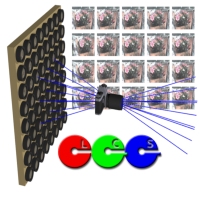
Image Based Synthetic Aperture Rendering
MIT9904-14
Start date: 07/99
MIT LCS
Hiroshi Murase
NTT
| Research Projects |  |
Image Based Synthetic Aperture RenderingMIT9904-14 Start date: 07/99 |
Leonard McMillan and Julie Dorsey MIT LCS Hiroshi Murase NTT |
Project summary |
|
The goal of the Synthetic-Aperture Camera Project is to develop new image-based representations for use in computer graphics. Our image-based representations are easy to acquire, yet they have similar flexibility and greater realism than traditional computer graphics models.
Project description |

|
Our representation uses a two-dimensional array of images to form a four-dimensional light field of any given scene. From this light field, we can compute novel new views of the captured scene with greater flexibility than a real camera and higher quality than a three-dimensional computer graphics model. Our work addresses the following problems:
The ultimate goal of this project is to construct a randomly accessible two-dimensional camera array capable of synthesizing novel views of dynamic scenes. |
Research Areas |
 We are designing a two-dimensional
camera array for acquiring and processing light fields in real time.
In fact, the entire camera array can be regarded as a dynamic light field
data structure. The pixels of each camera in the array are randomly accessible
by the host computer system, where the array is mapped as a block of memory.
These dynamic light fields are accessed "on-the-fly" to generate the
desired images. The memory-like interface used by our camera array significantly
reduces latency in the image generation process and makes the most effective use
of available bandwidth. The camera array will employ a modular design consisting of a motherboard,
sensor pods that support a range of imagers, and a PCI interface to the
host, optimized for high throughput. We are designing a two-dimensional
camera array for acquiring and processing light fields in real time.
In fact, the entire camera array can be regarded as a dynamic light field
data structure. The pixels of each camera in the array are randomly accessible
by the host computer system, where the array is mapped as a block of memory.
These dynamic light fields are accessed "on-the-fly" to generate the
desired images. The memory-like interface used by our camera array significantly
reduces latency in the image generation process and makes the most effective use
of available bandwidth. The camera array will employ a modular design consisting of a motherboard,
sensor pods that support a range of imagers, and a PCI interface to the
host, optimized for high throughput. |
|
|
|
|
In order to minimize cost we chose to use an off-the-shelf flatbed scanner as the digitizing element, in combination with a plastic lens array. However, intrinsic properties of scanner limit their use for acquiring images. We have developed a combination of low-cost optics and correction software to overcome these limitations. Currently we compensate for the following: color balance, radial distortion, camera calibration, noise removal, and sub-image segmentation.
|
|
|
Demos, movies and other examples |
Dynamically Reparameterized Light Fields Animations
|
|
These animation show how we can freely move around our dynamically reparameterized light fields. Throughout the MovingToys animation, we change the focal plane, camera orientation, and camera position. In the MovingTree animation, we vary the position and orientation of the camera. Because there is only one focal plane, a considerable amount of ghosting appears in these animations. This ghosting can be eliminated by 1) using a focal surface that conforms to the geometry of the scene, 2) using multiple focal planes that pass through the key features of the scene, 3) using a larger aperture such that ghosting turns into blur, or 4) sampling the camera surface at a higher resolution (using more cameras). The black regions occur when there is no ray in available in the ray database. |
|
|
The principal investigators |
Presentations and posters |
"Image-Based Synthetic Aperture Rendering", Leonard McMillan, Julie Dorsey and Hiroshi Murase, NTT, Musashino, Japan, January 2000. ![]()
"Dyamically Reparameterized Light Fields" Poster
![]()
 "Light Fields on the Cheap" Progress PowerPoint Presentation
"Light Fields on the Cheap" Progress PowerPoint Presentation ![]()
![]()
![]()
"Synthetic Aperture Camera Array" PowerPoint Presentation ![]()
![]()
![]()
Publications |
"Dynamically Reparameterized Light Fields", Aaron Isaksen, Leonard McMillan and Steven Gortler,
Technical Report MIT-LCS-TR-778, May 1999.
![]()
Proposals and progress reports |
Proposals:
NTT Bi-Annual Progress Report, July to December 1999:
NTT Bi-Annual Progress Report, January to June 2000:
NTT Bi-Annual Progress Report, July to December 2000:
NTT Bi-Annual Progress Report, January to June 2001:
For more information |